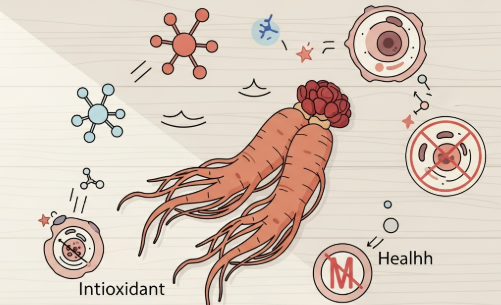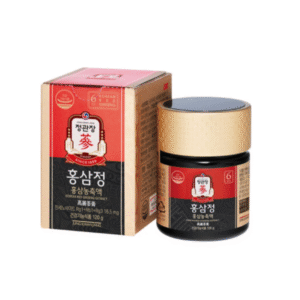On a cool autumn morning in Seoul, an elderly shopkeeper opens the wooden doors of his small herbal store. Inside, shelves are filled with neatly arranged jars of dried roots, red berries, and herbal powders. But one item always stands out—carefully displayed at eye level, protected behind a sheet of glass—Korean Red Ginseng.
Visitors point at it with curiosity; locals approach it with quiet respect. For centuries, this root has been treasured for strength, stamina, and vitality. But today, researchers are discovering something even more important: its remarkable anti-inflammatory and antioxidant properties.
This article explores how ginseng interacts with the body, what modern science says about its effects, and how its ancient reputation aligns with current evidence.
It is not medical advice—but a well-researched look at how one of the world’s most famous adaptogens may support overall wellness.
1. From Ancient Remedy to Modern Research: Why Inflammation Matters
To understand why ginseng is so valued, it helps to understand inflammation itself.
Imagine your body as a city. When a threat appears—like a virus, stress, pollution, or injury—your immune system sends out its “first responders.” This natural response, called acute inflammation, is helpful and protective.
But trouble begins when the response never stops.
🔥 Chronic inflammation is like a city stuck in constant emergency mode.
Over time, it may contribute to health challenges involving joints, heart function, metabolism, and general well-being.
This is why researchers have spent decades studying natural compounds that might support healthy inflammatory responses. And repeatedly, one plant keeps showing promising results: Panax ginseng.
2. What Makes Ginseng So Special? Ginsenosides, the Root’s Bioactive Stars
Ginseng contains a group of unique compounds called ginsenosides.
Think of them as the root’s “active language”—the way it communicates with the body.
Scientists currently recognize more than 40 different ginsenosides, each with slightly different effects. The most studied include Rg1, Rb1, Rg3, Rh2, and Rd, many of which have shown potential anti-inflammatory and antioxidant actions in laboratory and clinical studies.
The way these compounds work can be compared to a thermostat:
- When inflammation is too high, certain ginsenosides may help modulate immune signals.
- When oxidative stress increases, they may neutralize free radicals—reactive molecules that can damage cells over time.
This balancing effect is one reason ginseng is classified as an adaptogen—a natural substance believed to support the body’s ability to maintain equilibrium during stress.
3. How Ginseng May Help Reduce Inflammation
Research suggests several mechanisms through which ginseng may support a healthy inflammatory response.
a. Supporting Balanced Immune Signaling
Inflammation is driven by chemical messengers.
Some studies show that ginsenosides may help regulate specific pathways involved in inflammatory signals—such as NF-κB and cytokines—which play a role in how the body responds to stressors.
While these findings are promising, researchers emphasize that ginseng is not a replacement for medical treatment, but a potential supportive element in a wellness routine.
b. Supporting Joint Comfort and Tissue Health
Preclinical studies have shown that ginseng compounds may help maintain healthy cartilage and limit oxidative stress within joint tissue.
Although research in humans is ongoing, these pathways are an area of active interest among scientists studying joint wellness.
c. Helping the Body Recover from Daily Stress
Chronic stress can amplify inflammation.
As an adaptogen, ginseng may help support the body’s stress response systems—including the HPA axis—potentially contributing to more balanced physiological reactions.
Again, this should be viewed as supportive, not curative.
4. Ginseng’s Antioxidant Influence: Defending Cells from Oxidative Stress
If inflammation is like a fire, oxidative stress is the smoke that lingers afterwards.
Every day, our cells are exposed to free radicals generated by:
- environmental pollution
- poor diet
- UV radiation
- intense exercise
- emotional stress
Antioxidants act like shields, neutralizing these free radicals.
How ginseng contributes
Some ginsenosides appear to enhance the body’s natural antioxidant systems, such as superoxide dismutase (SOD) and glutathione—both crucial for cellular defense.
Other research suggests that ginseng may directly donate electrons to stabilize free radicals, functioning similarly to well-known antioxidants found in fruits and teas.
In simple terms:
Where oxidative stress rises, ginseng may help increase the body’s protective capacity.
5. Real-World Scenarios: Who Might Benefit from Antioxidant and Anti-Inflammatory Support?
While ginseng is not a treatment or cure, many people explore it as a general wellness supplement. Some examples include:
1. Individuals with high daily stress
Chronic stress can increase oxidative stress and inflammatory responses.
Adaptogens like ginseng may help support a sense of balance.
2. People with demanding physical routines
Athletes or workers with strenuous jobs might appreciate ginseng’s potential antioxidant support.
3. Adults concerned about long-term wellness
As oxidative stress is one factor associated with aging, some people include ginseng in their longevity-focused routines.
4. Individuals seeking natural wellness herbal options
Ginseng is often chosen by those looking for herbs traditionally used to support energy and resilience.
Again, these are general wellness perspectives, not medical recommendations.
6. Types of Ginseng and Why Korean Red Ginseng Is Often Highlighted
There are multiple species of ginseng, but Panax ginseng—especially Korean Red Ginseng—is the most researched.
What makes Korean Red Ginseng unique?
✔ A special steaming process
The roots are steamed and dried, which transforms certain ginsenosides and increases bioavailability.
✔ Higher concentration of key compounds
Red ginseng is known for containing elevated levels of Rg3 and Rh2—ginsenosides linked to antioxidant activity in experimental research.
✔ A centuries-long history of use
Traditional Korean medicine has used red ginseng for over 2,000 years to support vitality and balance.
This combination of tradition and modern research contributes to its global reputation.
7. Safety, Dosage, and Responsible Use
In line with Google’s health guidelines, it is important to emphasize:
- Ginseng should not be used as a substitute for medical treatment.
- Individuals with existing medical conditions should consult a qualified professional before use.
- Interactions with medications (such as blood thinners) may occur.
- Effects may vary depending on the individual and dosage.
Most studies evaluate standardized extracts or high-quality red ginseng products, often in the range of 200–400 mg of extract per day.
But again, guidance should come from a healthcare provider familiar with your personal situation.
8. A Root That Bridges Tradition and Science
What makes ginseng fascinating is not only its long history, but the way modern science is beginning to validate pieces of ancient tradition.
Research into ginseng’s anti-inflammatory and antioxidant potential continues to grow. While not conclusive or curative, the evidence suggests that this remarkable root may help support the body’s natural defenses against the everyday stressors of modern life.
It is a small reminder that sometimes, the earth’s simplest plants hold the most surprising complexity.







